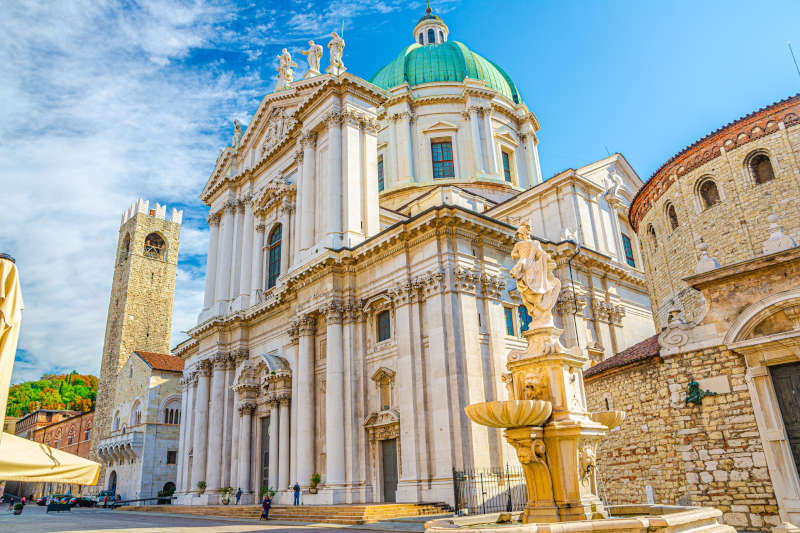
In these rival cities, football feuds and pandemic pain give way to walks, hilltop feasts, and cultural delights, creating superb destinations for an active Lombardy holiday.
In Piazza Vecchia, Città Alta, Bergamo’s medieval upper city, a young man dons a crimson and sunshine-yellow flower crown, surrounded by his family. As vino frizzante pops open, they raise royal blue cups for a joyous graduation toast.
The fading afternoon light adds a magical touch to this scene near the central Fontana Contarini. With its 16th-century Venetian walls and bustling restaurants nestled under grand stone archways, the area attracts visitors from all directions.
Arriving in a tuk-tuk as part of a guided tour with Elisabetta Campanini, we stroll past the Campanone, the city’s clock tower, set to chime 100 times at 10 pm—a reminder of the past when the city gates closed during Venetian rule. The tower’s top, reachable by foot (230 steps) or conveniently by elevator, offers a sweeping view of the city and a bird’s-eye perspective of the beautiful basilica of Santa Maria Maggiore below.
Descending into the basilica, constructed nearly nine centuries ago as a gesture of gratitude to the Virgin Mary for safeguarding Europe from a plague, we are greeted by an unabashedly opulent sight. Deep greens and golds of large handwoven tapestries, crafted in workshops across Florence and Flanders, embellish the walls. Everywhere one looks, Italian Renaissance painter Lorenzo Lotto’s intricate frescoes and stuccos adorn the interior.
Yet, what captivates me the most are the medieval paintings next to the basilica’s portals. Once concealed for ages under layers of paint, some of these artworks have now been restored. Although their colors appear flatter compared to more recent counterparts, their allure remains undiminished.
As we leisurely explore the city under Elisabetta’s guidance, she explains that Bergamo and its neighboring city, Brescia, have long lived in the shadow of Milan, the capital of Lombardy. However, in just a few hours, we witness the vibrancy of daily life in Bergamo and later experience the artsy ambiance of Brescia. Notably, Brescia boasts Roman relics, including the Santa Giulia Museum, which received world heritage status in 2011.
Both cities impress with their captivating architecture, delectable cuisine, and abundant access to nature. Remarkably, this year, the cities have set aside a 900-year-old feud, even overcoming the rivalry between supporters of their football teams, Brescia Calcio and Bergamo’s Atalanta BC, to unite as Italy’s first joint capitals of culture.
Both cities experienced severe repercussions from the pandemic, finding themselves at the epicenter of Europe’s first wave of coronavirus. The relentless sound of ambulance sirens filled the region day and night, leading to the loss of thousands of lives. The memories of that time continue to haunt the residents, evident in the profound sorrow that crosses their faces whenever the topic arises.
Despite the lingering effects, there is a collective determination to move forward and break free from the pandemic’s grip. Tourism is seen as a way to rejuvenate the cities, and to foster connectivity and healing, an 80-mile (130km) hiking trail called “La Via Delle Sorelle” (The Way of the Sisters) has been established, linking the two cities together.
Matteo Zanga, an experienced mountain leader, is my chosen guide for a 12-mile hike along the trail. Early one morning, we embark on our journey from the provincial village of Olera. The hillsides greet us with the delightful fragrance of wild garlic, while white wood anemones create a stunning floral carpet beneath our feet.
Throughout the trek, we meander past farms and venture through enchanting woodlands. Along the way, we make a detour to visit Ristorante Pighet, which is currently undergoing renovations and is set to reopen later this year. As we resume our hike on the trail, we come across an alpine festival taking place in an opening alongside the path, providing us with another opportunity to take a refreshing pit stop and savor a glass of wine.
The trail, situated in Lombardy’s north-eastern corner, showcases contemporary art and is suggested to be completed in six stages. Along the way, there are accommodations and dining options available. It winds through four parks and reserves, gradually descending toward Lake Iseo, and eventually connects with the Strada del Vino, a route that takes you through the renowned wine-making regions of Franciacorta, Valcalepio, and Terre del Vescovado, offering delightful opportunities to indulge in wine tastings.
Passing a group of female friends who are about to embark on the trail, we return to Città Alta and opt for lunch at Baretto, a charming restaurant situated in the upscale hilltop suburb of San Vigilio. It is during this meal that my perception of the city and the entire region solidifies.
As we navigate through the bustling crowd of people awaiting the funicular railway down to Città Alta, we find a seat on the restaurant’s terrace. I decide to try the traditional bergamasco appetizer of polenta, butter, and anchovies, where the briny seafood perfectly complements the nutty cornmeal. The mango sorbet serves as a refreshing palate cleanser, and the tiramisù del Baretto is exquisite. When I boldly order a cappuccino to end the meal, Matteo shares a good-natured laugh as Italians traditionally enjoy milky coffee only in the morning.



